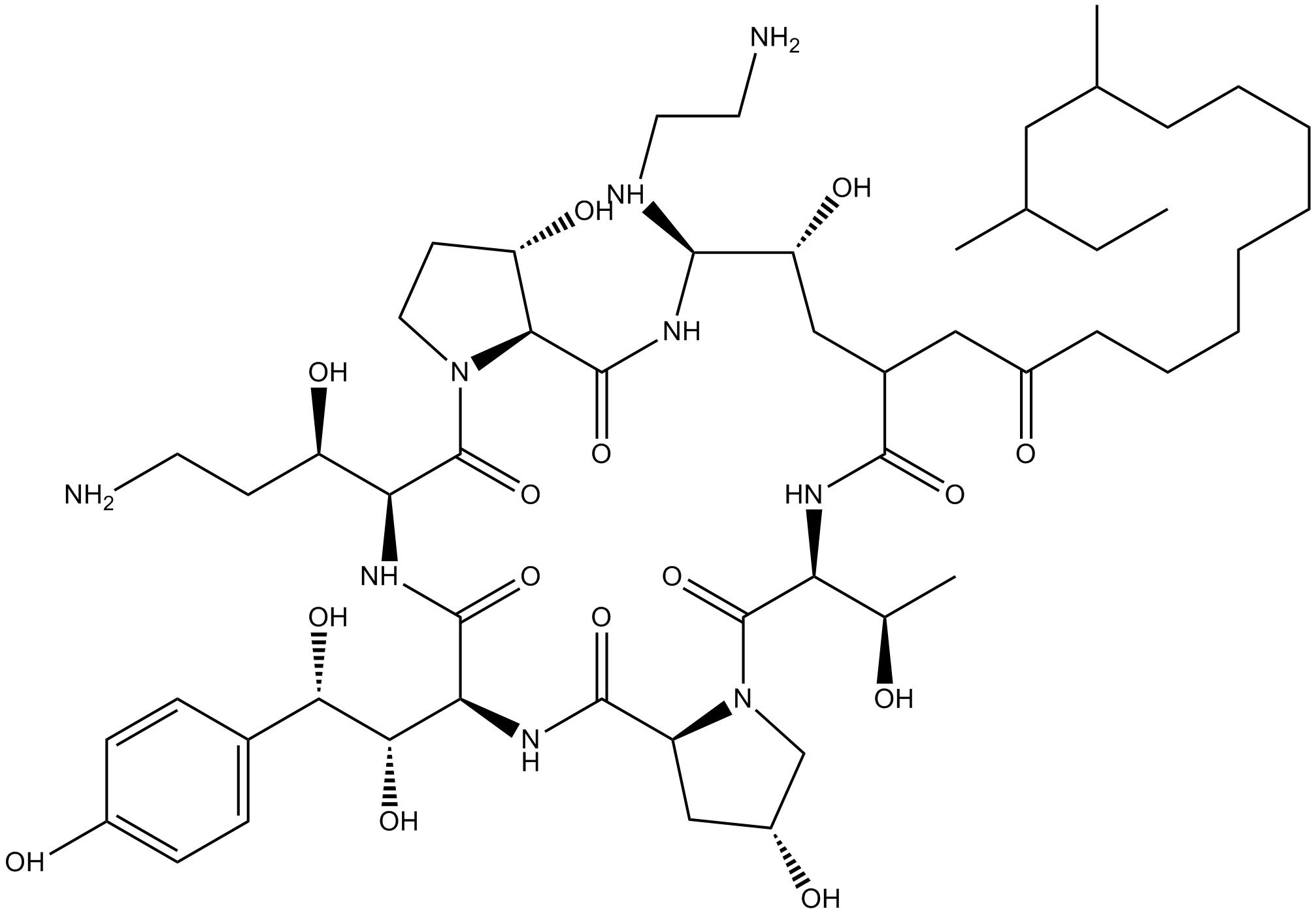Caspofungin |
| Catalog No.GC17230 |
Caspofungin is an echinocandin antifungal agent, which is used to treat a variety of fungal infections.
Products are for research use only. Not for human use. We do not sell to patients.

Cas No.: 162808-62-0
Sample solution is provided at 25 µL, 10mM.
Caspofungin is an echinocandin antifungal agent, which is used to treat a variety of fungal infections. Its antifungal effect is through inhibition β- 1,3-d-glucan polymer [1].
Caspofungin on cell membrane perturbation was not parallel to the increase of cytosolic Ca2 + activity and was insensitive to the removal of Ca2 + from the extracellular space. In addition, caspofungin triggered the translocation of phosphatidylserine to the surface of erythrocytes without increasing the abundance of ceramide. Caspofungin induced lupus erythematosus without inducing oxidative stress, and the addition of antioxidant N-acetylcysteine did not significantly change the effect of caspofungin on cell membrane perturbation. Caspase activation, p38 kinase or activity of staurosporin sensitive kinases such as protein kinase C are not required for the action of caspofungin. Therefore, the perturbation of cell membrane induced by caspofungin has nothing to do with the increase of cytosolic Ca2+. Activity, oxidative stress, ceramide formation or the activity of p38 kinase and astrosporin sensitive kinase are all the main inducements of lupus erythematosus [2]. In contrast, in the presence of d4476, a casein kinase inhibitor, the effect of caspofungin on cell membrane perturbation was attenuated. Therefore, the effect of caspofungin on cell membrane perturbation may involve the activation of casein kinase. However, the effect of d4476 other than casein kinase inhibition cannot be excluded. Moreover, caspofungin significantly enhanced the translocation of phosphatidylserine even in the presence of d4476, indicating that a further mechanism was involved [3].
Caspofungin induces hemolysis. The physiological function of eryptosis is actually to clear defective red blood cells in the circulating blood before hemolysis [2]. If defective erythrocytes fail to enter erythrocytosis in time, hemolysis leads to the release of hemoglobin, which passes through the glomerular filter and precipitates in the acidic lumen of the renal tubules, blocking the nephron, which may lead to renal failure [4].
Caspofungin showed limited antifungal activity in vitro and had limited efficacy in this lung challenge model. The survival rate was not significantly prolonged in the group of mice receiving a dose of caspofungin of 4 or 8 mg / kg / day. Amphotericin B at 2 mg / kg QD completely prevented death during the study. In addition, although amphotericin B significantly reduced the fungal load in the lungs and spleens, the administration of a higher dose (10 mg / kg twice daily) of caspofungin only reduced the quantitative culture colony count by 0.5 log compared with that used in the survival experiment [5]. Although this effect may not have clinical significance, it does indicate that caspofungin has an effect on H Capsulatum has certain activity The poor efficacy was not caused by insufficient dose, because a single IP dose of 1 mg / kg to mice produced 3 µ G/ml and 0.3 µ G / ml of blood [6].
References:
[1] Song J C, Stevens D A. Caspofungin: pharmacodynamics, pharmacokinetics, clinical uses and treatment outcomes[J]. Critical reviews in microbiology, 2016, 42(5): 813-846.
[2] Lang E, Lang F. Mechanisms and pathophysiological significance of eryptosis, the suicidal erythrocyte death[C]//Seminars in cell & developmental biology. Academic Press, 2015, 39: 35-42.
[3] Peter T, Bissinger R, Lang F. Stimulation of eryptosis by caspofungin[J]. Cellular Physiology and Biochemistry, 2016, 39(3): 939-949.
[4] Harrison H E, Bunting H, Ordway N K, et al. The pathogenesis of the renal injury produced in the dog by hemoglobin or methemoglobin[J]. The Journal of Experimental Medicine, 1947, 86(4): 339-356.
[5] Kohler S, Wheat L J, Connolly P, et al. Comparison of the echinocandin caspofungin with amphotericin B for treatment of histoplasmosis following pulmonary challenge in a murine model[J]. Antimicrobial agents and chemotherapy, 2000, 44(7): 1850-1854.
[6] Hajdu R, Thompson R, Sundelof J G, et al. Preliminary animal pharmacokinetics of the parenteral antifungal agent MK-0991 (L-743,872)[J]. Antimicrobial agents and chemotherapy, 1997, 41(11): 2339-2344.
Average Rating: 5 (Based on Reviews and 21 reference(s) in Google Scholar.)
GLPBIO products are for RESEARCH USE ONLY. Please make sure your review or question is research based.
Required fields are marked with *




















